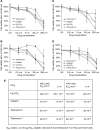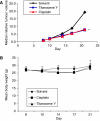Substituted titanocenes induce caspase-dependent apoptosis in human epidermoid carcinoma cells in vitro and exhibit antitumour activity in vivo
- PMID: 17923871
- PMCID: PMC2360460
- DOI: 10.1038/sj.bjc.6604021
Substituted titanocenes induce caspase-dependent apoptosis in human epidermoid carcinoma cells in vitro and exhibit antitumour activity in vivo
Abstract
Titanocene compounds are a novel series of agents that exhibit cytotoxic effects in a variety of human cancer cells in vitro and in vivo. In this study, the antiproliferative activity of two titanocenes (Titanocenes X and Y) was evaluated in human epidermoid cancer cells in vitro. Titanocenes X and Y induce apoptotic cell death in epidermoid cancer cells, with IC50 values that are comparable to cisplatin. Characterisation of the cell death pathway induced by titanocene compounds in A431 cells revealed that apoptosis is preceded by cell cycle arrest and the inhibition of cell proliferation. The induction of apoptosis is dependent on the activation of caspase-3 and -7 but not caspase-8. Furthermore, the antitumour activity of Titanocene Y was tested in an A431 xenograft model of epidermoid cancer. Results indicate that Titanocene Y significantly reduced the growth of A431 xenografts with an antitumour effect similar to cisplatin. These results suggest that titanocenes represent a novel series of promising antitumour agents.
Figures






Similar articles
-
Novel titanocene anti-cancer drugs and their effect on apoptosis and the apoptotic pathway in prostate cancer cells.Apoptosis. 2006 Jul;11(7):1205-14. doi: 10.1007/s10495-006-6796-1. Apoptosis. 2006. PMID: 16699961
-
In-vitro anti-tumor activity studies of bridged and unbridged benzyl-substituted titanocenes.Anticancer Drugs. 2005 Nov;16(10):1091-8. doi: 10.1097/00001813-200511000-00008. Anticancer Drugs. 2005. PMID: 16222151
-
The role of caspase family protease, caspase-3 on cisplatin-induced apoptosis in cisplatin-resistant A431 cell line.Cancer Chemother Pharmacol. 2000;46(3):241-5. doi: 10.1007/s002800000145. Cancer Chemother Pharmacol. 2000. PMID: 11021742
-
Mechanisms of cytotoxicity of anticancer titanocenes.Anticancer Agents Med Chem. 2010 May;10(4):302-11. doi: 10.2174/187152010791162261. Anticancer Agents Med Chem. 2010. PMID: 20380637 Review.
-
Bioorganometallic fulvene-derived titanocene anti-cancer drugs.Chem Soc Rev. 2008 Jun;37(6):1174-87. doi: 10.1039/b707310k. Epub 2008 Apr 2. Chem Soc Rev. 2008. PMID: 18497930 Review.
Cited by
-
Heterometallic titanium-gold complexes inhibit renal cancer cells in vitro and in vivo.Chem Sci. 2015 Sep 1;6(9):5269-5283. doi: 10.1039/C5SC01753J. Epub 2015 Jun 23. Chem Sci. 2015. PMID: 27213034 Free PMC article.
-
Bioactive O^N^O^ Schiff base appended homoleptic titanium(iv) complexes: DFT, BSA/CT-DNA interactions, molecular docking and antitumor activity against HeLa and A549 cell lines.RSC Adv. 2024 Apr 22;14(19):13062-13082. doi: 10.1039/d3ra08574k. eCollection 2024 Apr 22. RSC Adv. 2024. PMID: 38655487 Free PMC article.
-
A proposed mechanism for the inhibitory effect of the anticancer agent titanocene dichloride on tumour gelatinases and other proteolytic enzymes.J Biol Inorg Chem. 2009 Aug;14(6):947-57. doi: 10.1007/s00775-009-0507-7. Epub 2009 Apr 24. J Biol Inorg Chem. 2009. PMID: 19390879
-
Preparation of Titanocene-Gold Compounds Based on Highly Active Gold(I)-N-Heterocyclic Carbene Anticancer Agents: Preliminary in vitro Studies in Renal and Prostate Cancer Cell Lines.ChemMedChem. 2019 Jun 5;14(11):1086-1095. doi: 10.1002/cmdc.201800796. Epub 2019 Apr 12. ChemMedChem. 2019. PMID: 30924298 Free PMC article.
-
Synthesis, structure, ionochromic and cytotoxic properties of new 2-(indolin-2-yl)-1,3-tropolones.Beilstein J Org Chem. 2025 Feb 17;21:358-368. doi: 10.3762/bjoc.21.26. eCollection 2025. Beilstein J Org Chem. 2025. PMID: 39996166 Free PMC article.
References
-
- Beckhove P, Hanauske A-R, Oberschmidt O, Pampillon C, Schirrmacher V, Strohfeldt K, Sweeney NJ, Tacke M (2007) Antitumor activity of Titanocene Y in freshly explanted human breast tumours and in xenografted Mcf-7 tumors in mice. Anticancer Drugs 18: 311–315 - PubMed
-
- Cummings BS, Schnellmann RG (2002) Cisplatin-induced renal cell apoptosis: caspase 3-dependent and -independent pathways. J Pharmacol Exp Ther 302: 8–17 - PubMed
-
- Farrell N, Povirk LF, Dange Y, DeMasters G, Gupta MS, Kohlhagen G, Khan QA, Pommier Y, Gewirtz DA (2004) Cytotoxicity, DNA strand breakage and DNA-protein crosslinking by a novel transplatinum compound in human A2780 ovarian and MCF-7 breast carcinoma cells. Biochem Pharmacol 68: 857–866 - PubMed
-
- Farrell N, Qu Y, Roberts JD (1999) Chemistry and biology of multifunctional DNA binding agents. Top Biol Inorg Chem 1: 99–115
-
- Fichtner I, Pampillon C, Sweeney NJ, Strohfeldt K, Tacke M (2006) Anti-tumor activity of Titanocene Y in xenografted Caki-1 tumors in mice. Anticancer Drugs 17: 333–336 - PubMed
MeSH terms
Substances
LinkOut - more resources
Full Text Sources
Other Literature Sources
Research Materials

